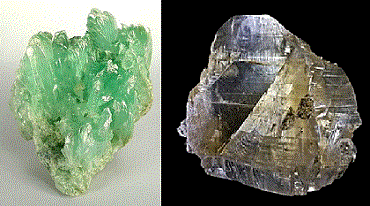 |
| talc (left) and gypsum (right) |
Right out of the box, Martinez jumped on the chief difference between the two minerals: they are defined as numbers 1 (talc) and 2 (gypsum) on the Mohs scale of mineral hardness. Right here, props to Christina for not pulling the usual eHow sin of inserting an apostrophe into the surname of Friedrich Mohs... after that, however, she displayed serious misunderstanding of Mohs' work, babbling that,
"The Mohs Hardness Scale is the primary scale that tests a rock’s [sic] hardness by how easily it can be scratched. Diamond has a score of 10 on the hardness scale, which is the highest a mineral can obtain. Talc has a score of 1, and gypsum has a score of 2, which makes these two minerals similar and difficult to differentiate between."
No, Christina, rocks do not have hardness, minerals do. While we're at it, minerals do not have a "score" on the Mohs scale. For that matter, a mineral's hardness on the scale isn't determined by "how easily it can be scratched," because the scale defines relative hardness: labradorite, a mineral with hardness 3½, is harder than calcite (3) but softer than fluorite (4). But that does not mean that labradorite is 3½ times as hard as talc. No, it's actually about 18 times as hard as talc on an absolute hardness scale.
Christina's ignorance of mineralogy weaves throughout (basically correct) factoids in her post, yet another example of how padding facts to meet the DMS² minimum word count so often leads to a DotD award. Take, for example, her explanation of cleavage:
"Fragment pieces of each rock with your fingernail. If cleavage fragments fall off and are tiny, the specimen is talc. Cleavage on talc is perfect. Cleavage is the quality of a split along defined planes of a rock [sic] or mineral."
We have no idea why Martinez decided that cleavage fragments of talc are "tiny." We do know that her statement that "Cleavage on [sic] talc is perfect" is a bastardization of talc's Wikipedia entry that states, "Perfect on {001} basal cleavage" – it would help had Martinez known in this context, "perfect" means smooth, shiny, and easy to create. What Martinez neglects to mention is that gypsum displays not one but two cleavage planes, one of which is also "perfect." Duh.
We also liked the ambiguity of,
"If the rock is slippery, it may be talc. If the rock isn’t slippery it may be gypsum."
Heck, Christina, if it isn't slippery, it may be diamond! And how about her attempt to explain streak:
"Scratch each piece of rock. If powder falls off and doesn’t feel slippery or greasy, it’s gypsum."
Once more, talc and gypsum are minerals. Feh.
OK, here's the answer our Dumbass of the Day should have provided:
Gypsum is, by definition, harder than talc. Gypsum's streak is always white, talc's can range from white to dark gray. The specific gravity of gypsum is about 2.3, that of talc is 2.6 to 2.8.
'Nuff said.
¹ Staffers who one wrote for eHow.com tell us that science content was found under "Hobbies, Games and Toys" in eHow's filing system. We kid you not.
² The site owners, now Leaf Group, are a direct lineal descendant of Demand Media Studios – known to many as "DMS," as in "You can't spell 'dumbass' without 'DMS.'"
² The site owners, now Leaf Group, are a direct lineal descendant of Demand Media Studios – known to many as "DMS," as in "You can't spell 'dumbass' without 'DMS.'"
SI - MINERALS
No comments:
Post a Comment